aps审核--计算机组成与结构Computer Organization Architecture
- 格式:docx
- 大小:145.06 KB
- 文档页数:3
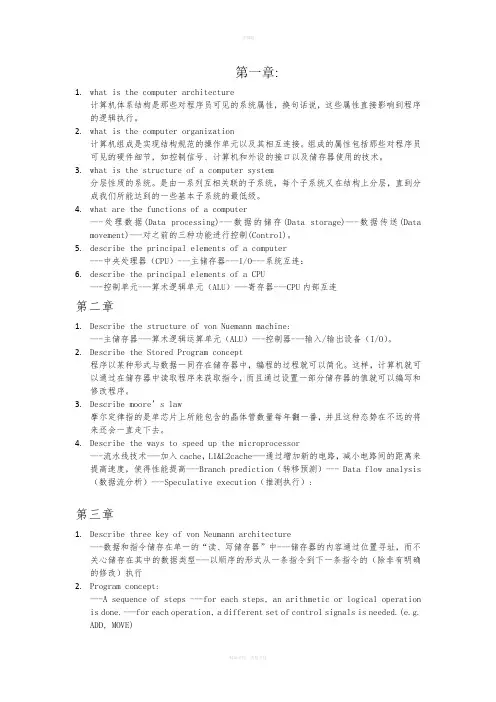
第一章:1.what is the computer architecture计算机体系结构是那些对程序员可见的系统属性,换句话说,这些属性直接影响到程序的逻辑执行。
2.what is the computer organization计算机组成是实现结构规范的操作单元以及其相互连接。
组成的属性包括那些对程序员可见的硬件细节,如控制信号、计算机和外设的接口以及储存器使用的技术。
3.what is the structure of a computer system分层性质的系统。
是由一系列互相关联的子系统,每个子系统又在结构上分层,直到分成我们所能达到的一些基本子系统的最低级。
4.what are the functions of a computer---处理数据(Data processing)---数据的储存(Data storage)---数据传送(Data movement)---对之前的三种功能进行控制(Control)。
5.describe the principal elements of a computer---中央处理器(CPU)---主储存器---I/O---系统互连:6.describe the principal elements of a CPU---控制单元---算术逻辑单元(ALU)---寄存器---CPU内部互连第二章1.Describe the structure of von Nuemann machine:---主储存器---算术逻辑运算单元(ALU)---控制器---输入/输出设备(I/O)。
2.Describe the Stored Program concept程序以某种形式与数据一同存在储存器中,编程的过程就可以简化。
这样,计算机就可以通过在储存器中读取程序来获取指令,而且通过设置一部分储存器的值就可以编写和修改程序。
3.Describe moore’s law摩尔定律指的是单芯片上所能包含的晶体管数量每年翻一番,并且这种态势在不远的将来还会一直走下去。
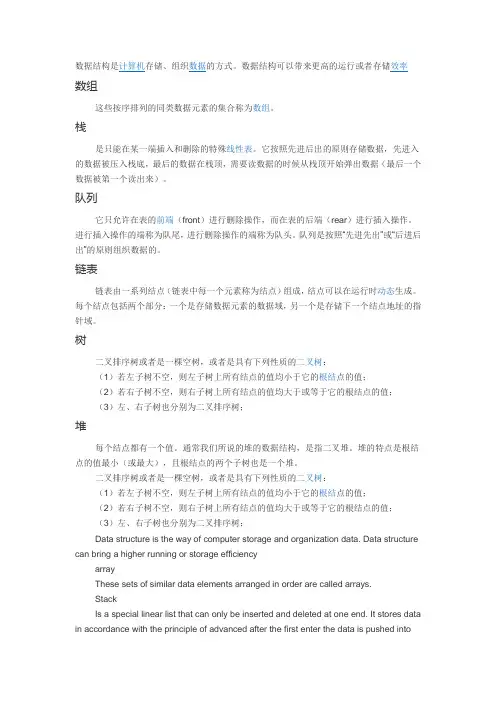
数组这些按序排列的同类数据元素的集合称为数组。
栈是只能在某一端插入和删除的特殊线性表。
它按照先进后出的原则存储数据,先进入的数据被压入栈底,最后的数据在栈顶,需要读数据的时候从栈顶开始弹出数据(最后一个数据被第一个读出来)。
队列它只允许在表的前端(front)进行删除操作,而在表的后端(rear)进行插入操作。
进行插入操作的端称为队尾,进行删除操作的端称为队头。
队列是按照“先进先出”或“后进后出”的原则组织数据的。
链表链表由一系列结点(链表中每一个元素称为结点)组成,结点可以在运行时动态生成。
每个结点包括两个部分:一个是存储数据元素的数据域,另一个是存储下一个结点地址的指针域。
树二叉排序树或者是一棵空树,或者是具有下列性质的二叉树:(1)若左子树不空,则左子树上所有结点的值均小于它的根结点的值;(2)若右子树不空,则右子树上所有结点的值均大于或等于它的根结点的值;(3)左、右子树也分别为二叉排序树;堆每个结点都有一个值。
通常我们所说的堆的数据结构,是指二叉堆。
堆的特点是根结点的值最小(或最大),且根结点的两个子树也是一个堆。
二叉排序树或者是一棵空树,或者是具有下列性质的二叉树:(1)若左子树不空,则左子树上所有结点的值均小于它的根结点的值;(2)若右子树不空,则右子树上所有结点的值均大于或等于它的根结点的值;(3)左、右子树也分别为二叉排序树;Data structure is the way of computer storage and organization data. Data structure can bring a higher running or storage efficiencyarrayThese sets of similar data elements arranged in order are called arrays.StackIs a special linear list that can only be inserted and deleted at one end. It stores data in accordance with the principle of advanced after the first enter the data is pushed intothe stack, the final data in the stack, need to read data when the data are beginning to pop up from the top of the stack (the last data is read out first).queueIt only allows the front end of the table (front) to delete the operation, and in the back end of the table (rear) to insert the operation. The end of the insertion operation called the end of the team, the end of the delete operation called the head of the team. The queue is organized in accordance with the principle of "advanced first out" or "backward".linked listThe linked list is composed of a series of nodes (called nodes in the list), which can be dynamically generated at runtime. Each node consists of two parts: one is the data field that stores the data elements, and the other is a pointer field that stores the next node address.treeTwo fork sort tree or an empty tree, or has the following nature of the two fork tree:(1) if the left sub tree is not empty, the value of all the nodes in the left tree is smaller than the value of its root node;(2) if the right subtree is not empty, then the right subtree on all nodes of the value is greater than or equal to the value of its root node;(3) the left and right subtree are respectively two binary sort tree;heapEach node has a value. Usually we say the pile of data structure, refers to the two fork heap. The heap is characteristic of the root node of the minimum value (or maximum), and the two is the root node of the subtree of a heap.Two fork sort tree or an empty tree, or has the following nature of the two fork tree:(1) if the left sub tree is not empty, the value of all the nodes in the left tree is smaller than the value of its root node;(2) if the right subtree is not empty, then the right subtree on all nodes of the value is greater than or equal to the value of its root node;(3) the left and right subtree are respectively two binary sort tree;面向对象对象指的是类的实例。
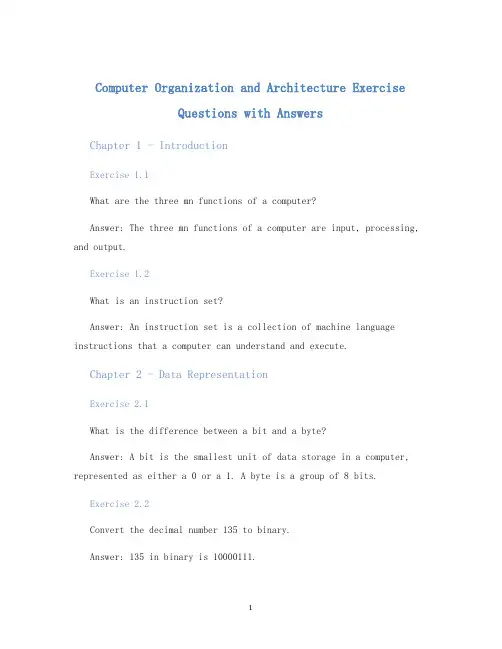
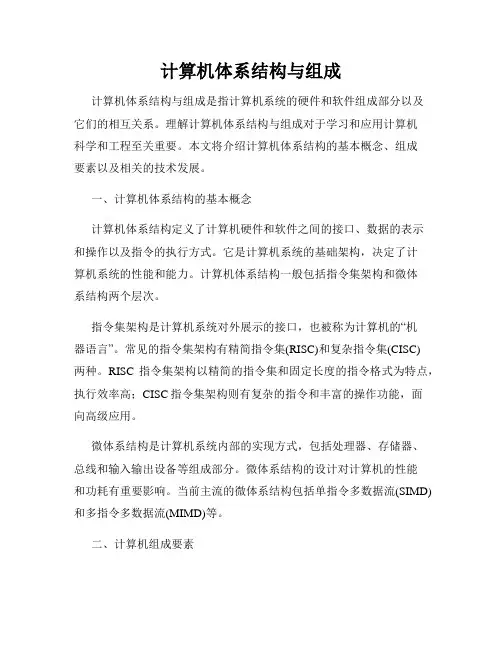
计算机体系结构与组成计算机体系结构与组成是指计算机系统的硬件和软件组成部分以及它们的相互关系。
理解计算机体系结构与组成对于学习和应用计算机科学和工程至关重要。
本文将介绍计算机体系结构的基本概念、组成要素以及相关的技术发展。
一、计算机体系结构的基本概念计算机体系结构定义了计算机硬件和软件之间的接口、数据的表示和操作以及指令的执行方式。
它是计算机系统的基础架构,决定了计算机系统的性能和能力。
计算机体系结构一般包括指令集架构和微体系结构两个层次。
指令集架构是计算机系统对外展示的接口,也被称为计算机的“机器语言”。
常见的指令集架构有精简指令集(RISC)和复杂指令集(CISC)两种。
RISC指令集架构以精简的指令集和固定长度的指令格式为特点,执行效率高;CISC指令集架构则有复杂的指令和丰富的操作功能,面向高级应用。
微体系结构是计算机系统内部的实现方式,包括处理器、存储器、总线和输入输出设备等组成部分。
微体系结构的设计对计算机的性能和功耗有重要影响。
当前主流的微体系结构包括单指令多数据流(SIMD)和多指令多数据流(MIMD)等。
二、计算机组成要素计算机系统由多个基本组成要素构成,每个组成要素都承担着特定的功能和任务。
1. 中央处理器(CPU):是计算机的核心部件,负责执行指令、处理数据和控制计算机系统的运行。
CPU包括算术逻辑单元(ALU)、控制单元(CU)和寄存器等部分。
2. 存储器:用于存储程序和数据。
主存储器(RAM)是计算机的主要工作空间,用于存储正在执行的程序和数据;辅助存储器(如硬盘、固态硬盘)则用于长期存储数据和文件。
3. 输入输出设备:用于与外部世界进行信息的输入和输出。
常见的输入设备包括键盘、鼠标、触摸屏等;输出设备包括显示器、打印机、音频设备等。
4. 总线:负责计算机内部各个组件之间的信息传输。
总线分为数据总线、地址总线和控制总线三种类型,分别用于传输数据、地址和控制信号。
三、计算机体系结构的发展计算机体系结构和组成都经历了多次变革和创新,在不同的发展阶段出现了各种不同的体系结构和组成方案。
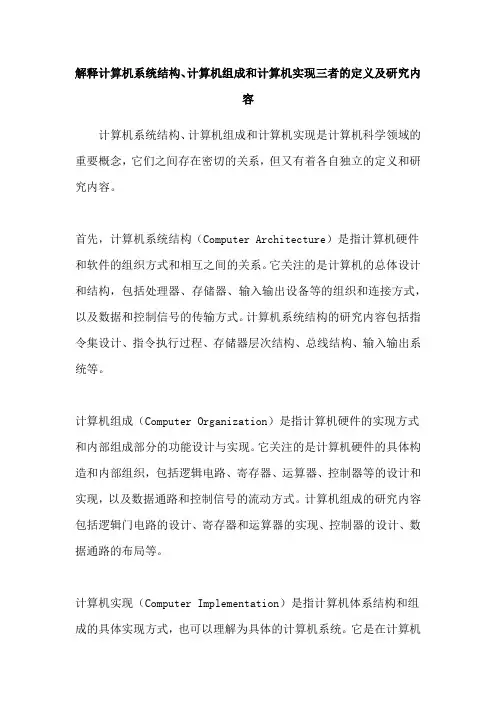
解释计算机系统结构、计算机组成和计算机实现三者的定义及研究内容计算机系统结构、计算机组成和计算机实现是计算机科学领域的重要概念,它们之间存在密切的关系,但又有着各自独立的定义和研究内容。
首先,计算机系统结构(Computer Architecture)是指计算机硬件和软件的组织方式和相互之间的关系。
它关注的是计算机的总体设计和结构,包括处理器、存储器、输入输出设备等的组织和连接方式,以及数据和控制信号的传输方式。
计算机系统结构的研究内容包括指令集设计、指令执行过程、存储器层次结构、总线结构、输入输出系统等。
计算机组成(Computer Organization)是指计算机硬件的实现方式和内部组成部分的功能设计与实现。
它关注的是计算机硬件的具体构造和内部组织,包括逻辑电路、寄存器、运算器、控制器等的设计和实现,以及数据通路和控制信号的流动方式。
计算机组成的研究内容包括逻辑门电路的设计、寄存器和运算器的实现、控制器的设计、数据通路的布局等。
计算机实现(Computer Implementation)是指计算机体系结构和组成的具体实现方式,也可以理解为具体的计算机系统。
它是在计算机系统结构和计算机组成的基础上进行具体的设计和实现,包括选择硬件平台、设计和实现硬件电路、编写底层软件等。
计算机实现的研究内容包括硬件设计与制造、操作系统开发、编译器和驱动程序的编写等。
三者之间的关系是计算机系统结构提供了计算机的总体设计和组织方式,计算机组成根据计算机系统结构的要求进行硬件部分的具体设计和实现,而计算机实现则将计算机系统结构和组成转化为具体的计算机系统。
在计算机系统研究领域,人们通过对计算机系统结构、计算机组成和计算机实现的研究,可以提高计算机的性能和可靠性,设计出更高效的计算机系统,开发出更强大的应用软件,实现各种计算任务的需求。
同时,这些研究还可以推动和促进计算机技术的发展和进步,推动计算机科学的研究和应用。
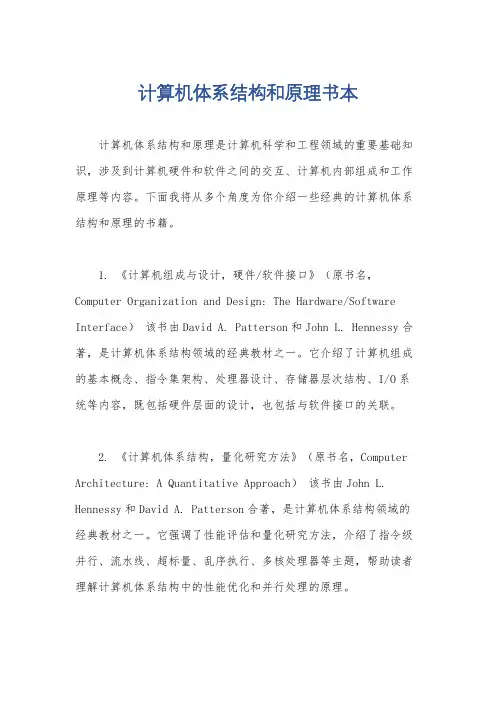
计算机体系结构和原理书本计算机体系结构和原理是计算机科学和工程领域的重要基础知识,涉及到计算机硬件和软件之间的交互、计算机内部组成和工作原理等内容。
下面我将从多个角度为你介绍一些经典的计算机体系结构和原理的书籍。
1. 《计算机组成与设计,硬件/软件接口》(原书名,Computer Organization and Design: The Hardware/Software Interface)该书由David A. Patterson和John L. Hennessy合著,是计算机体系结构领域的经典教材之一。
它介绍了计算机组成的基本概念、指令集架构、处理器设计、存储器层次结构、I/O系统等内容,既包括硬件层面的设计,也包括与软件接口的关联。
2. 《计算机体系结构,量化研究方法》(原书名,Computer Architecture: A Quantitative Approach)该书由John L. Hennessy和David A. Patterson合著,是计算机体系结构领域的经典教材之一。
它强调了性能评估和量化研究方法,介绍了指令级并行、流水线、超标量、乱序执行、多核处理器等主题,帮助读者理解计算机体系结构中的性能优化和并行处理的原理。
3. 《计算机体系结构,量化方法、结构和设计》(原书名,Computer Architecture: A Quantitative Approach, Structured Approach)该书由Miles J. Murdocca和Vincent P. Heuring合著,是一本介绍计算机体系结构的综合教材。
它涵盖了计算机系统的各个层面,包括数字逻辑、指令集架构、处理器设计、存储器和I/O系统等,旨在帮助读者理解计算机系统的组成和工作原理。
4. 《计算机体系结构》(原书名,Computer Architecture: A Quantitative Approach)该书由William Stallings合著,是一本综合介绍计算机体系结构的教材。
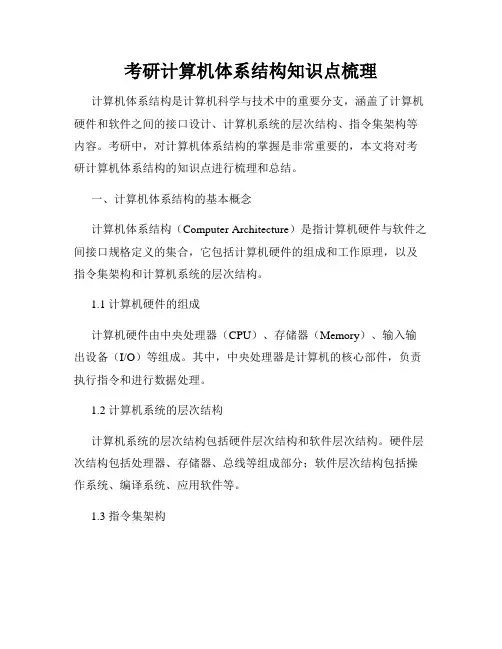
考研计算机体系结构知识点梳理计算机体系结构是计算机科学与技术中的重要分支,涵盖了计算机硬件和软件之间的接口设计、计算机系统的层次结构、指令集架构等内容。
考研中,对计算机体系结构的掌握是非常重要的,本文将对考研计算机体系结构的知识点进行梳理和总结。
一、计算机体系结构的基本概念计算机体系结构(Computer Architecture)是指计算机硬件与软件之间接口规格定义的集合,它包括计算机硬件的组成和工作原理,以及指令集架构和计算机系统的层次结构。
1.1 计算机硬件的组成计算机硬件由中央处理器(CPU)、存储器(Memory)、输入输出设备(I/O)等组成。
其中,中央处理器是计算机的核心部件,负责执行指令和进行数据处理。
1.2 计算机系统的层次结构计算机系统的层次结构包括硬件层次结构和软件层次结构。
硬件层次结构包括处理器、存储器、总线等组成部分;软件层次结构包括操作系统、编译系统、应用软件等。
1.3 指令集架构指令集架构(Instruction Set Architecture,ISA)定义了计算机系统的指令集合和指令的编码格式。
常见的指令集架构包括精简指令集(RISC)和复杂指令集(CISC)。
二、计算机的性能指标在计算机体系结构中,常用的性能指标有时钟周期、时钟频率、执行时间和吞吐量等。
2.1 时钟周期和时钟频率时钟周期是指计算机系统中最小的时间单位,是计算机进行一次简单操作所需要的时间。
时钟频率是指计算机系统每秒钟进行时钟周期的次数。
2.2 执行时间执行时间是指计算机完成一个程序的时间,它等于指令执行的总周期数乘以时钟周期。
执行时间是衡量计算机性能的重要指标,通常以秒为单位。
2.3 吞吐量吞吐量是指计算机系统在单位时间内完成的任务数量。
吞吐量大表示计算机系统的处理能力强,可以同时处理更多的任务。
三、指令的执行流程计算机处理器执行指令的流程包括指令获取、指令译码、指令执行和结果写回等步骤。
3.1 指令获取指令获取是指计算机从存储器中获取指令的过程。
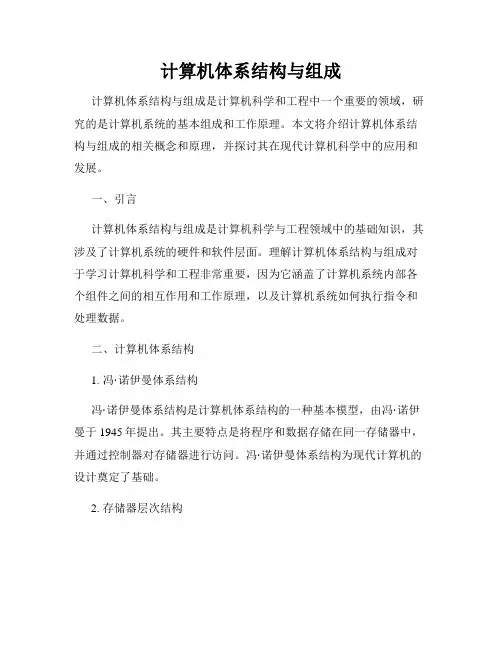
计算机体系结构与组成计算机体系结构与组成是计算机科学和工程中一个重要的领域,研究的是计算机系统的基本组成和工作原理。
本文将介绍计算机体系结构与组成的相关概念和原理,并探讨其在现代计算机科学中的应用和发展。
一、引言计算机体系结构与组成是计算机科学与工程领域中的基础知识,其涉及了计算机系统的硬件和软件层面。
理解计算机体系结构与组成对于学习计算机科学和工程非常重要,因为它涵盖了计算机系统内部各个组件之间的相互作用和工作原理,以及计算机系统如何执行指令和处理数据。
二、计算机体系结构1. 冯·诺伊曼体系结构冯·诺伊曼体系结构是计算机体系结构的一种基本模型,由冯·诺伊曼于1945年提出。
其主要特点是将程序和数据存储在同一存储器中,并通过控制器对存储器进行访问。
冯·诺伊曼体系结构为现代计算机的设计奠定了基础。
2. 存储器层次结构计算机系统中的存储器层次结构将存储器按照访问速度和容量划分为多个层次,从高速缓存到主存再到外部存储器。
不同层次的存储器在性能和成本之间进行权衡,以提供高效的数据访问。
3. 指令系统指令系统定义了计算机系统支持的指令集和指令的操作方式。
常见的指令系统包括精简指令集(RISC)和复杂指令集(CISC)等。
指令系统直接影响了计算机系统的性能和可编程性。
三、计算机组成1. 中央处理器(CPU)中央处理器是计算机系统的核心组件,负责执行指令和处理数据。
CPU包括运算单元和控制单元,运算单元执行算术和逻辑运算,控制单元协调各个组件的操作。
2. 存储器存储器包括主存储器和辅助存储器,用于存储程序和数据。
主存储器是CPU直接访问的存储空间,而辅助存储器如硬盘和闪存则用于长期存储数据。
3. 输入输出设备输入输出设备负责计算机系统与外部世界的信息交换。
常见的输入设备包括键盘和鼠标,输出设备包括显示器和打印机。
四、现代计算机体系结构与组成的应用1. 并行计算并行计算利用多个处理器同时执行任务,以提高计算速度和问题解决能力。
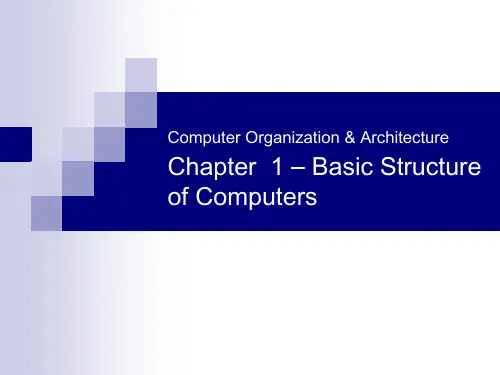
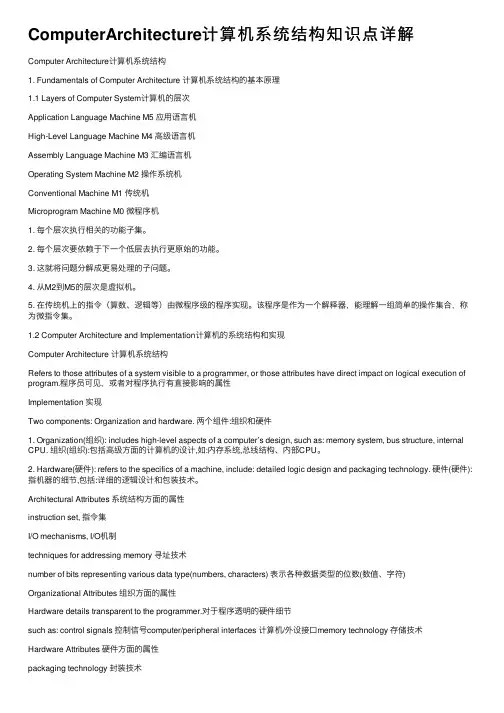
ComputerArchitecture计算机系统结构知识点详解Computer Architecture计算机系统结构1. Fundamentals of Computer Architecture 计算机系统结构的基本原理1.1 Layers of Computer System计算机的层次Application Language Machine M5 应⽤语⾔机High-Level Language Machine M4 ⾼级语⾔机Assembly Language Machine M3 汇编语⾔机Operating System Machine M2 操作系统机Conventional Machine M1 传统机Microprogram Machine M0 微程序机1. 每个层次执⾏相关的功能⼦集。
2. 每个层次要依赖于下⼀个低层去执⾏更原始的功能。
3. 这就将问题分解成更易处理的⼦问题。
4. 从M2到M5的层次是虚拟机。
5. 在传统机上的指令(算数、逻辑等)由微程序级的程序实现。
该程序是作为⼀个解释器,能理解⼀组简单的操作集合,称为微指令集。
1.2 Computer Architecture and Implementation计算机的系统结构和实现Computer Architecture 计算机系统结构Refers to those attributes of a system visible to a programmer, or those attributes have direct impact on logical execution of program.程序员可见,或者对程序执⾏有直接影响的属性Implementation 实现Two components: Organization and hardware. 两个组件:组织和硬件1. Organization(组织): includes high-level aspects of a computer’s design, such as: memory system, bus structure, internal CPU. 组织(组织):包括⾼级⽅⾯的计算机的设计,如:内存系统,总线结构、内部CPU。
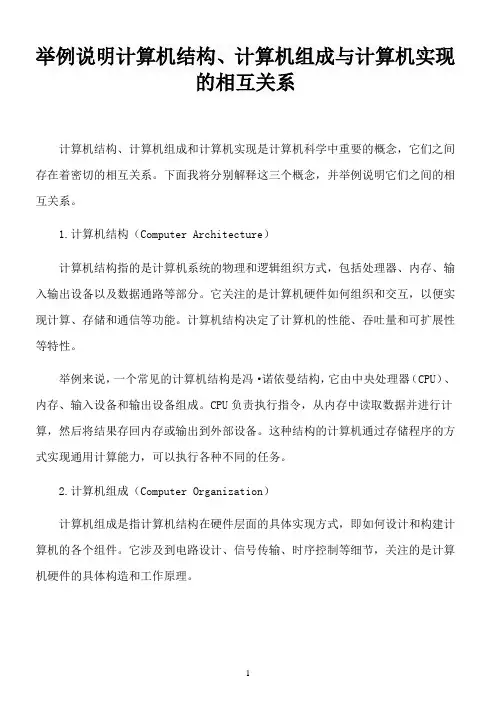
举例说明计算机结构、计算机组成与计算机实现的相互关系计算机结构、计算机组成和计算机实现是计算机科学中重要的概念,它们之间存在着密切的相互关系。
下面我将分别解释这三个概念,并举例说明它们之间的相互关系。
1.计算机结构(Computer Architecture)计算机结构指的是计算机系统的物理和逻辑组织方式,包括处理器、内存、输入输出设备以及数据通路等部分。
它关注的是计算机硬件如何组织和交互,以便实现计算、存储和通信等功能。
计算机结构决定了计算机的性能、吞吐量和可扩展性等特性。
举例来说,一个常见的计算机结构是冯·诺依曼结构,它由中央处理器(CPU)、内存、输入设备和输出设备组成。
CPU负责执行指令,从内存中读取数据并进行计算,然后将结果存回内存或输出到外部设备。
这种结构的计算机通过存储程序的方式实现通用计算能力,可以执行各种不同的任务。
2.计算机组成(Computer Organization)计算机组成是指计算机结构在硬件层面的具体实现方式,即如何设计和构建计算机的各个组件。
它涉及到电路设计、信号传输、时序控制等细节,关注的是计算机硬件的具体构造和工作原理。
举例来说,计算机组成可能涉及到CPU的微体系结构设计,包括指令集、流水线、缓存等方面的设计。
这些设计决定了CPU的性能和效率。
另外,计算机组成还包括内存的组织方式、总线的设计、输入输出设备的接口等方面的考虑。
3.计算机实现(Computer Implementation)计算机实现是指将计算机结构和计算机组成转化为实际可运行的计算机系统的过程。
它包括硬件的制造和组装、操作系统的安装配置以及软件的开发和部署等环节。
计算机实现是将计算机结构和计算机组成的概念应用于实际的计算机系统中。
举例来说,当一个计算机结构和组成被设计完成后,制造商可以根据这些设计制造出真正的计算机硬件,然后将操作系统和应用软件安装在这台计算机上,使其能够运行各种任务。
Computer Organization and Architecture English CourseDesignAbstractIn this course design, we will focus on the basic principles of computer organization and architecture. Specifically, we will cover the design of computer systems at the hardware level, including topics such as digital logic circuits, assembly language programming, memory hierarchy, and processor design. Throughout the course, we will also cover some of the fundamental concepts of computer architecture, such as pipelining, caching, virtual memory, and parallelism.IntroductionThe mn goal of this course is to provide students with a comprehensive understanding of computer organization and architecture, from the underlying digital logic circuits to the design of modern computer systems. The course is intended for students who have a basic understanding of digital logic and assembly language programming, and who are interested in learning more about the inner workings of computer hardware.Throughout the course, we will take a hands-on approach to learning, with regular lab assignments that will give students the opportunity to work with real-world computer systems and components. We will also cover some of the latest developments in computer architecture, including the use of GPUs and other specialized hardware to accelerate performance.Course ContentModule 1: Introduction to Computer OrganizationIn this module, we will cover the basics of computer organization, including the different types of computer systems, and the role of the operating system in managing hardware resources. We will also cover some of the key components of computer systems, such as the CPU, memory, and storage devices.Module 2: Digital Logic CircuitsIn this module, we will cover the fundamentals of digital logic circuits, including Boolean algebra, logic gates, and combinational and sequential circuits. We will also cover the use of logic gates to build basic computer components such as adders and multiplexers.Module 3: Assembly Language ProgrammingIn this module, we will cover the basics of assembly language programming, including the use of registers and memory, and thestructure of assembly language programs. We will also cover the basics of debugging and optimization.Module 4: Memory HierarchyIn this module, we will cover the organization of memory in a computer system, including the use of caches and virtual memory. We will also cover the tradeoffs between different levels of memory hierarchy, and the techniques used to optimize memory performance.Module 5: Processor DesignIn this module, we will cover the basics of modern processor design, including pipelining and parallelism. We will also cover the use of specialized hardware, such as GPUs, to accelerate performance.ConclusionOverall, this course is designed to provide students with a solid foundation in computer organization and architecture, with a focus on the design of computer systems at the hardware level. By the end of the course, students should have a good understanding of the basic principles of digital logic circuits, assembly language programming, memory hierarchy, and processor design, as well as some of the latest developments in computer architecture. The course will also provide students with hands-on experience working with real-world computer systems and components, which should be valuable for anyone interested in a career in computer engineering or related fields.。
计算机系统基础英语
"计算机系统基础"涉及计算机科学领域的核心概念和基础知识。
以下是该主题的一些子主题:
1. 计算机组成与结构(Computer Organization and Architecture):计算机硬件组成、CPU、存储器、输入输出设备、指令集架构等方面的原理和结构。
2. 操作系统(Operating Systems):操作系统的功能、管理资源、进程调度、内存管理、文件系统、并发控制等基本概念。
3. 数据结构与算法(Data Structures and Algorithms):数据结构包括数组、链表、栈、队列、树等;算法包括排序、查找、图算法、动态规划等。
4. 计算机网络(Computer Networks):网络协议、通信原理、网络拓扑、数据传输、网络安全等网络基础知识。
5. 软件工程(Software Engineering):软件开发周期、软件设计原则、软件测试、质量保证、版本控制等软件工程方面的基本概念。
6. 计算理论(Theory of Computation):自动机理论、图灵机、计算复杂性理论等计算模型和理论方面的基础知识。
这些领域是计算机科学基础课程中的核心内容,为学生提供了对计算机系统和软件工程原理的基本理解,有助于他们在后续学习和职业发展中建立扎实的基础。
计算机体系结构和组织计算机体系结构和组织的重要组成部分包括中央处理器(Central Processing Unit,CPU)、存储器(Memory)、输入输出(Input/Output,I/O)系统以及总线(Bus)等。
中央处理器是计算机的核心组件,负责执行指令和进行计算。
存储器用于存储程序和数据。
输入输出系统负责计算机与外部设备的交互。
总线是连接这些组件的通信路径。
中央处理器是计算机体系结构的关键组成部分。
它由控制单元(Control Unit)、算术逻辑单元(Arithmetic Logic Unit,ALU)和寄存器组成。
控制单元负责指令的解码和执行,它通过控制总线和其他组件进行通信。
算术逻辑单元执行算术和逻辑操作。
寄存器用于存储指令和数据,它们可以快速访问。
存储器是计算机体系结构的另一个重要组成部分。
它分为主存储器(Main Memory)和辅助存储器(Secondary Storage)。
主存储器是计算机与CPU之间的交互介质,它用于存储正在运行的程序和数据。
辅助存储器用于长期存储数据和程序,如硬盘和固态硬盘。
输入输出系统允许计算机与外部设备进行交互。
它包括输入设备(如键盘和鼠标)和输出设备(如显示器和打印机)。
输入输出系统负责将外部设备的数据转换为计算机可以处理的格式,并将计算机的结果转换为外部设备可以接受的格式。
总线是计算机体系结构中连接各个组件的通信路径。
它分为地址总线(Address Bus)、数据总线(Data Bus)和控制总线(Control Bus)。
地址总线用于传输内存地址,数据总线用于传输数据,控制总线用于传输控制信号。
总结来说,计算机体系结构和组织是计算机科学领域的重要概念,涉及计算机硬件组成部分之间的关系以及数据和信息如何在这些硬件之间流动。
它包括指令集架构、计算机组织和操作系统等重要概念。
中央处理器、存储器、输入输出系统和总线是计算机体系结构和组织的关键组成部分。
计算机组成与体系结构
计算机组成与体系结构是计算机科学领域中的一个重要学科,主
要研究计算机系统的构成和组成原理,以及对其性能和功能进行优化
和改进的方法和技术。
计算机组成与体系结构涉及到计算机硬件、操
作系统和应用软件等多个领域,是计算机科学中的核心领域之一。
计算机组成主要研究计算机系统中的各个硬件组件,包括中央处
理器(CPU)、随机存储器(RAM)、输入输出设备、总线等,通过对
硬件的控制和优化,提高计算机系统的性能和功能。
而计算机体系结
构则针对整个计算机系统进行设计,包括计算机硬件组件的选择、架
构设计和指令系统设计等方面,通过对计算机系统的整体优化,提高
其性能和功能。
计算机组成与体系结构的研究内容十分广泛,包括计算机系统的
结构、指令系统、存储器层次结构、输入输出系统、总线结构、中断
处理、微处理器设计和高性能计算等方面。
其主要应用领域包括计算
机系统的设计和开发、系统性能分析和优化、计算机系统教育和研究等。
总之,计算机组成与体系结构是计算机科学中的一个核心领域,
对提高计算机系统的性能和功能有着重要的作用。
未来随着计算机技
术的不断进步,计算机组成与体系结构的研究也将会不断发展和完善。
计算机体系结构和计算机组成原理
计算机体系结构和计算机组成原理是计算机科学中非常重要的两个概念。
计算机体系结构是指计算机硬件和软件之间的接口,它定义了计算机的组成部分以及它们之间的关系。
计算机组成原理则是指计算机硬件的实现方式,包括处理器、存储器、输入输出设备等。
计算机体系结构和计算机组成原理是密不可分的。
计算机体系结构的设计必须考虑到计算机组成原理的实现方式,而计算机组成原理的实现方式也必须符合计算机体系结构的要求。
例如,计算机体系结构中的指令集架构(ISA)定义了计算机的指令集和寄存器,而计算机组成原理则负责实现这些指令和寄存器。
计算机体系结构和计算机组成原理的发展历程可以追溯到计算机诞生的早期。
早期的计算机采用的是电子管和继电器等元器件,这些元器件的体积庞大、功耗高、寿命短,限制了计算机的发展。
随着半导体技术的发展,计算机的体积逐渐缩小,功耗降低,性能提高。
现代计算机采用的是微处理器、内存芯片、硬盘等集成电路,这些元器件的体积小、功耗低、寿命长,使得计算机的性能得到了极大的提升。
计算机体系结构和计算机组成原理的发展也推动了计算机应用的发展。
计算机的应用范围从最初的科学计算扩展到了商业、娱乐、通信等领域。
计算机的应用也从单机应用扩展到了分布式应用、云计算等新兴领域。
计算机体系结构和计算机组成原理是计算机科学中非常重要的两个概念。
它们的发展推动了计算机技术的进步,也推动了计算机应用的发展。
未来,随着人工智能、物联网等新兴技术的发展,计算机体系结构和计算机组成原理的研究将会更加深入,为人类带来更多的便利和创新。
This course covers is a top-down approach to computer design.
Topics:
●Computer architecture, introduction to assembly language programming and machine
language set design;
●Computer organization, logical modules; CPU, memory and I/O units
●Instruction cycles, the datapath and control unit; Hardwiring and microprogramming
●The memory subsystem and timing; I/O interface, interrupts, programmed I/O and DMA
●Introduction to pipelining and memory hierarchies
●Fundamentals of computer networks
1.1 Overviews
The architecture is the set of resources visible to the machine language programmer: Registers, the memory, data representations, addressing modes, instructions formats, control states, I/O controllers, interrupts, etc.
The organization is the set of resources that realizes the architecture which include the CPU, the memory and I/O controllers. These are digital systems with registers, buses, ALUs, sequencers, etc.
●The CPU is responsible for running machine language programs: It runs machine language
instructions. Running a machine language instruction is performing a simple operation (command) on data.
●The memory keeps the programs and data, leading to the stored program concept of today’s
computers.
●I/O controllers interface the I/O devices to the memory and CPU. An I/O controller can
control one or more I/O devices. Often the number of I/O devices connected to an I/O controller depends on the speed of I/O devices.
Machine language set should be
●Complex (complex instruction set computer, CISC)
●Simple (reduced instruction set computer, RISC).
1.2 A digital system performs microoperations
It consists of a datapath (data unit) and a control unit
●The datapath (data unit) has registers, ALUs and buses to perform the microoperations
●The control unit determines which microoperation happens when microoperation happens
1.3 Architectural operations
An architectural operation is what we describe as the semantics of the instruction, such as
●The architectural operation specified by the ADD instruction
Rd ← Rs + Rt
●The architectural operation specified by the SUB instruction
Rd ← Rs - Rt
●The architectural operation specified by the SLT instruction
If Rs < Rt then Rd ← 1 else Rd ← 0
●The architectural operation specified by the J instruction
PC[27-0] ← (Address * 4)
Typical CPU digital system microoperations
●Add, subtract, multiply
In the past, a 32-bit addition was completed in 1 clock period.
Today, a 32-bit addition is completed in several clock periods
●AND, OR, XOR
●Shift right, Shift left
●Read data from memory, write data to memory
In the past, a memory access was completed in 1 clock period.
Today, it is completed in several clock periods
●Read instructions from memory (fetch)
●Increment the program counter
●Transfer a register to another register
1.4 Microoperations
●The CPU can perform one or more microoperations per clock period, depending on the
complexity of the microoperation and the availability of the hardware resources
●The more and complex the microoperations are, the longer it takes to run the machine
language instruction
The time it takes to run an instruction, CPI i, is then determined by
●The number of microoperations needed for it
●The complexity of the microoperations
1.5 Integer instructions that include
●LW, SW
●ADD, SUB, SLT, AND, OR
●BEQ, J
2. Relation with other courses:。